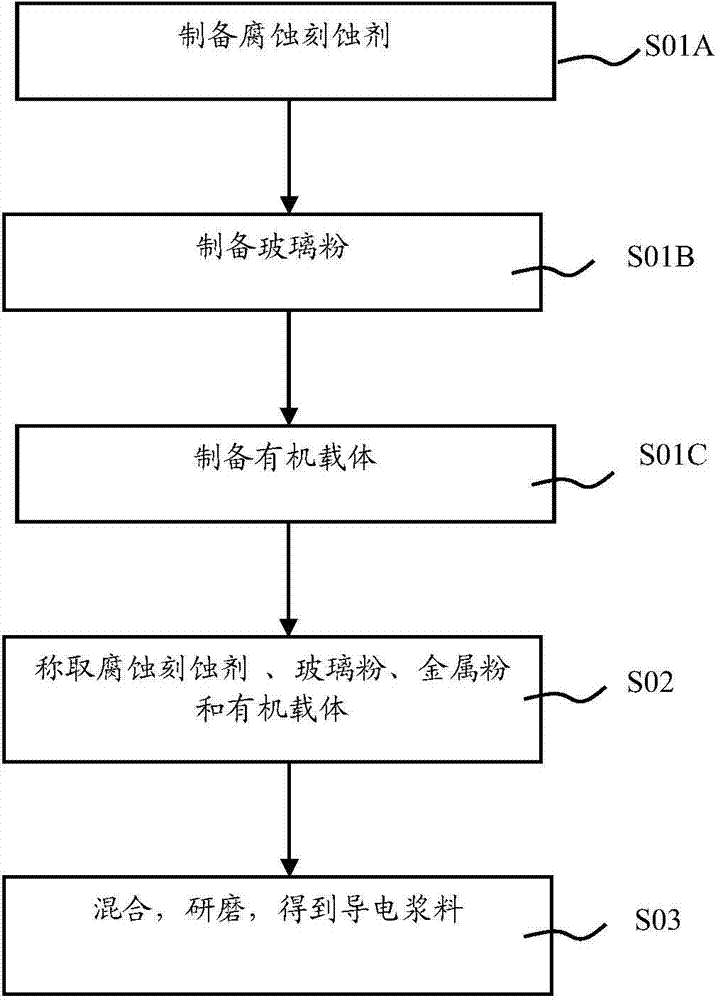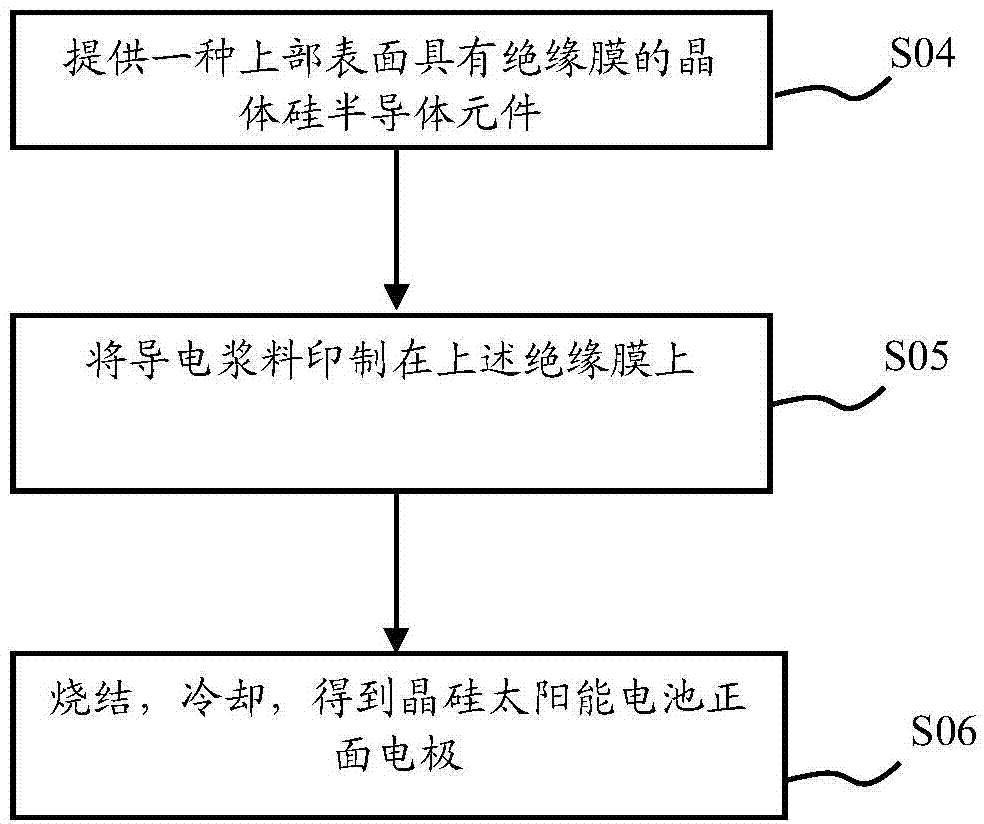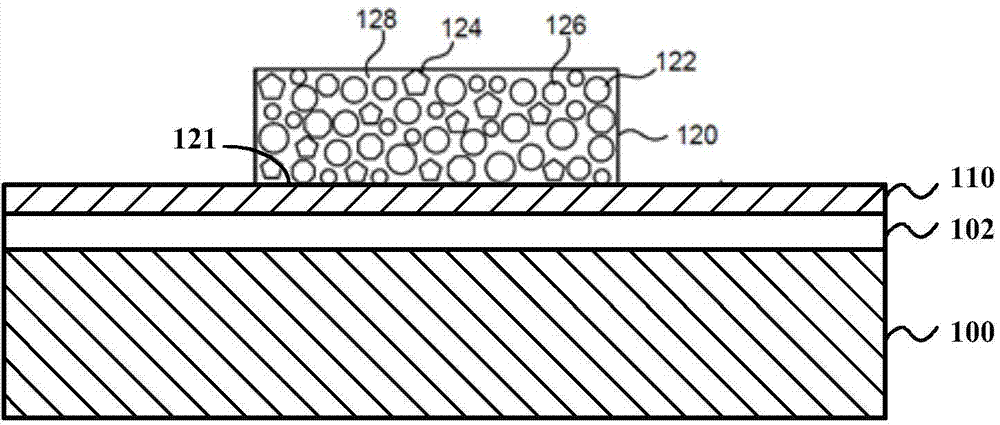Crystalline silicon solar cell front electrode electrocondution slurry and preparation method thereof
A technology of solar cells and front electrodes, applied in the field of solar cells, can solve the problems of difficult glass powder and paste production, narrow process window, etc., and achieve the effects of enhanced contact, good ohmic contact, and stable structure
- Summary
- Abstract
- Description
- Claims
- Application Information
AI Technical Summary
Problems solved by technology
Method used
Image
Examples
preparation example Construction
[0075] figure 2It is a schematic flow chart of the method for preparing the front electrode of a crystalline silicon solar cell by using the above-mentioned conductive paste. The method for preparing the front electrode of a high-performance crystalline silicon solar cell provided by the embodiment of the present invention includes the following steps:
[0076] S04, providing a crystalline silicon semiconductor element with an insulating film on the upper surface, wherein the insulating film is a stacked layer of at least one of silicon nitride, titanium oxide, aluminum oxide, and silicon oxide;
[0077] S05, printing the conductive paste on the front electrode of the crystalline silicon solar cell on the insulating film in step S04;
[0078] S06, sintering; the sintering step is: drying the conductive paste printed on the insulating film at 180°C to 260°C, heating to 720°C to 900°C for sintering, and during the sintering process, the corrosion The etchant becomes liquid and...
Embodiment example 1
[0124] Exemplary Implementation Case 1: First, 14g TeO 2 and 8.75g Pb 3 o 4 Mix the oxide powders, then add 0.75g Al 2 o 3 and 1.5g Li 2 CO 3 The oxide powder is further mixed evenly, then placed in a crucible, put into a heating furnace, heated to 900°C, and reacted in a molten state for 60 minutes in an air atmosphere at 900°C, and then the molten mixture Take it out from the furnace and let it cool naturally in the atmosphere to form a block. The obtained blocks are pulverized to obtain small particles, and the small particles are ball milled to form a powder, and the ball milled powder is in the range of 0.1-15 μm to obtain its crystal compound. The molten mixture had a temperature of 900°C in the furnace and dropped to 732°C after removal from the furnace. Figure 5 It is the relationship between the cooling time and temperature of the molten mixture after it is taken out of the furnace. The record starts from 732°C. It can be seen that it is cooled from 732°C to 5...
Embodiment example 1
[0125] Comparative Implementation Case 1: First, 14g TeO 2 and 8.75g Pb 3 o 4 Mix the oxide powders, then add 0.75g Al 2 o 3 and 1.5g Li 2 CO 3 The oxide powder is further uniformly mixed, then placed in a crucible, placed in a heating furnace, heated to 900°C, and reacted in a molten state for 60 minutes in an air atmosphere at 900°C, and then the molten The mixture was removed from the furnace and quenched by pouring into deionized water at 25°C to obtain a block. The obtained block is crushed to obtain small particles, and the small particles are then ball milled to form a powder, and the ball milled powder D 50 In the range of 0.1-15 μm, glass powder is obtained. The glass powder prepared in the above-mentioned implementation case has been analyzed and tested by XRD, and the results are as follows: Figure 6b shown. Depend on Figure 6b It can be seen that the XRD test of the glass powder shows a bulge with a wide distribution and low intensity, without showing a...
PUM
| Property | Measurement | Unit |
|---|---|---|
| size | aaaaa | aaaaa |
| thickness | aaaaa | aaaaa |
| melting point | aaaaa | aaaaa |
Abstract
Description
Claims
Application Information
 Login to View More
Login to View More - R&D
- Intellectual Property
- Life Sciences
- Materials
- Tech Scout
- Unparalleled Data Quality
- Higher Quality Content
- 60% Fewer Hallucinations
Browse by: Latest US Patents, China's latest patents, Technical Efficacy Thesaurus, Application Domain, Technology Topic, Popular Technical Reports.
© 2025 PatSnap. All rights reserved.Legal|Privacy policy|Modern Slavery Act Transparency Statement|Sitemap|About US| Contact US: help@patsnap.com



